An Investigation of the Restitution Coefficient Impact on Simulating Sand-Char Mixing in a Bubbling Fluidized Bed
Abstract
:1. Introduction
2. Model Description
3. Simulation Setup
4. Results and Discussion
4.1. Stationary Condition
4.2. Particle Velocity and Flow Pattern
4.3. Granular Temperature Distribution
4.4. Distribution of Particle Volume Fraction
5. Conclusions
Author Contributions
Conflicts of Interest
References
- Fan, X.; Yang, Z.; Parker, D.J. Impact of solid sizes on flow structure and particle motions in bubbling fluidization. Powder Technol. 2011, 206, 132–138. [Google Scholar] [CrossRef]
- Mohd Salleh, M.A.; Kisiki, N.H.; Yusuf, H.M.; Ab Karim Ghani, W.A.W. Gasification of Biochar from Empty Fruit Bunch in a Fluidized Bed Reactor. Energies 2010, 3, 1344–1352. [Google Scholar] [CrossRef]
- Liu, H.; Zhao, Y.; Ding, J.; Gidaspow, D.; Wei, L. Investigation of mixing/segregation of mixture particles in gas-solid fluidized beds. Chem. Eng. Sci. 2007, 62, 301–317. [Google Scholar]
- Coroneo, M.; Mazzei, L.; Lettieri, P.; Paglianti, A.; Montante, G. CFD prediction of segregating fluidized bidisperse mixtures of particles differing in size and density in gas-solid fluidized beds. Chem. Eng. Sci. 2011, 66, 2317–2327. [Google Scholar] [CrossRef]
- Sun, J.; Wang, J.; Yang, Y. CFD investigation of particle fluctuation characteristics of bidisperse mixture in a gas-solid fluidized bed. Chem. Eng. Sci. 2012, 82, 285–298. [Google Scholar] [CrossRef]
- Loha, C.; Chattopadhyay, H.; Chatterjee, P.K. Euler-Euler CFD modeling of fluidized bed: Influence of specularity coefficient on hydrodynamic behavior. Particuology 2013, 11, 673–680. [Google Scholar] [CrossRef]
- Bakshi, A.; Altantzis, C.; Bates, R.B.; Ghoniem, A.F. Eulerian–Eulerian simulation of dense solid–gas cylindrical fluidized beds: Impact of wall boundary condition and drag model on fluidization. Powder Technol. 2015, 277, 47–62. [Google Scholar] [CrossRef]
- Wang, Y.; Zou, Z.; Li, H.; Zhu, Q. A new drag model for TFM simulation of gas-solid bubbling fluidized beds with Geldart-B particles. Particuology 2014, 15, 151–159. [Google Scholar] [CrossRef]
- Johnson, P.C.; Jackson, R. Frictional-collisional constitutive relations for granular materials with application to plane shearing. J. Fluid Mech. 1987, 176, 67–93. [Google Scholar] [CrossRef]
- Chao, Z.; Wang, Y.; Jakobsen, J.P.; Fernandino, M.; Jakobsen, H.A. Derivation and validation of a binary multi-fluid Eulerian model for fluidized beds. Chem. Eng. Sci. 2011, 66, 3605–3616. [Google Scholar] [CrossRef]
- Bai, W.; Keller, N.K.G.; Heindel, T.J.; Fox, R.O. Numerical study of mixing and segregation in a biomass fluidized bed. Powder Technol. 2013, 237, 355–366. [Google Scholar] [CrossRef]
- Tagliaferri, C.; Mazzei, L.; Lettieri, P.; Marzocchella, A.; Olivieri, G.; Salatino, P. CFD simulation of bubbling fluidized bidisperse mixtures: Effect of integration methods and restitution coefficient. Chem. Eng. Sci. 2013, 102, 324–334. [Google Scholar] [CrossRef]
- Mostafazadeh, M.; Rahimzadeh, H.; Hamzei, M. Numerical analysis of the mixing process in a gas-solid fluidized bed reactor. Powder Technol. 2013, 239, 422–433. [Google Scholar] [CrossRef]
- Zhong, H.; Gao, J.; Xu, C.; Lan, X. CFD modeling the hydrodynamics of binary particle mixtures in bubbling fluidized beds: Effect of wall boundary condition. Powder Technol. 2012, 230, 232–240. [Google Scholar] [CrossRef]
- Xue, Q.; Heindel, T.J.; Fox, R.O. A CFD model for biomass fast pyrolysis in fluidized-bed reactors. Chem. Eng. Sci. 2011, 66, 2440–2452. [Google Scholar] [CrossRef]
- Askarishahi, M.; Salehi, M.-S.; Molaei Dehkordi, A. Numerical investigation on the solid flow pattern in bubbling gas–solid fluidized beds: Effects of particle size and time averaging. Powder Technol. 2014, 264, 466–476. [Google Scholar] [CrossRef]
- Sande, P.C.; Ray, S. Mesh size effect on CFD simulation of gas-fluidized Geldart A particles. Powder Technol. 2014, 264, 43–53. [Google Scholar] [CrossRef]
- Wang, Y.; Chao, Z.; Jakobsen, H.A. A sensitivity study of the two-fluid model closure parameters (β, e) Determing the main gas-solid flow pattern characteristics. Ind. Eng. Chem. Res. 2010, 49, 3433–3441. [Google Scholar] [CrossRef]
- Zhong, H.; Lan, X.; Gao, J.; Zheng, Y.; Zhang, Z. The difference between specularity coefficient of 1 and no-slip solid phase wall boundary conditions in CFD simulation of gas-solid fluidized beds. Powder Technol. 2015, 286, 740–743. [Google Scholar] [CrossRef]
- Lun, C.C.K.; Savage, S.B.; Jeffrey, D.J.; Chepurniy, N. Kinetic theories for granular flow: Inelastic particles in Couette flow and slightly inelastic particles in a general flow field. J. Fluid Mech. 1984, 140, 223–256. [Google Scholar] [CrossRef]
- Park, H.C.; Choi, H.S. The segregation characteristics of char in a fluidized bed with varying column shapes. Powder Technol. 2013, 246, 561–571. [Google Scholar] [CrossRef]
- Gelderbloom, S.J.; Gidaspow, D.; Lyczkowski, R.W. CFD Simulations of Bubbling/Collapsing Fluidized Beds for Three Geldart Groups. AIChE J. 2003, 49, 844–858. [Google Scholar] [CrossRef]
- Chen, J.; Yu, G.; Dai, B.; Liu, D.; Zhao, L. CFD simulation of a bubbling fluidized bed gasifier using a bubble-based drag model. Energy Fuels 2014, 28, 6351–6360. [Google Scholar] [CrossRef]
- Chao, Z.; Wang, Y.; Jakobsen, J.P.; Fernandino, M.; Jakobsen, H.A. Multi-fluid modeling of density segregation in a dense binary fluidized bed. Particuology 2012, 10, 62–71. [Google Scholar] [CrossRef]
- Verma, V.; Deen, N.G.; Padding, J.T.; Kuipers, J.A.M. Two-fluid modeling of three-dimensional cylindrical gas–solid fluidized beds using the kinetic theory of granular flow. Chem. Eng. Sci. 2013, 102, 227–245. [Google Scholar] [CrossRef]
- Zhong, H.; Lan, X.; Gao, J.; Xu, C. Effect of particle frictional sliding during collisions on modeling the hydrodynamics of binary particle mixtures in bubbling fluidized beds. Powder Technol. 2014, 254, 36–43. [Google Scholar] [CrossRef]
- Yang, S.; Luo, K.; Fang, M.; Fan, J. LES–DEM investigation of the solid transportation mechanism in a 3-D bubbling fluidized bed. Part II: Solid dispersion and circulation properties. Powder Technol. 2014, 256, 395–403. [Google Scholar] [CrossRef]
- Di Renzo, A.; Di Maio, F.P.; Girimonte, R.; Vivacqua, V. Segregation direction reversal of gas-fluidized biomass/inert mixtures—Experiments based on particle segregation model predictions. Chem. Eng. J. 2015, 262, 727–736. [Google Scholar] [CrossRef]
- Li, T.; Grace, J.; Bi, X. Study of wall boundary condition in numerical simulations of bubbling fluidized beds. Powder Technol. 2010, 203, 447–457. [Google Scholar] [CrossRef]
- Zhao, Y.; Lu, B.; Zhong, Y. Influence of collisional parameters for rough particles on simulation of a gas-fluidized bed using a two-fluid model. Int. J. Multiph. Flow 2015, 71, 1–13. [Google Scholar] [CrossRef]
- Asegehegn, T.W.; Schreiber, M.; Krautz, H.J. Influence of two- and three-dimensional simulations on bubble behavior in gas-solid fluidized beds with and without immersed horizontal tubes. Powder Technol. 2012, 219, 9–19. [Google Scholar] [CrossRef]
- Xie, N.; Battaglia, F.; Pannala, S. Effects of using two-versus three-dimensional computational modeling of fluidized beds. Powder Technol. 2008, 182, 1–13. [Google Scholar] [CrossRef]
- Geng, S.; Jia, Z.; Zhan, J.; Liu, X.; Xu, G. CFD modeling the hydrodynamics of binary particle mixture in pseudo-2D bubbling fluidized bed: Effect of model parameters. Powder Technol. 2016, 302, 384–395. [Google Scholar] [CrossRef]
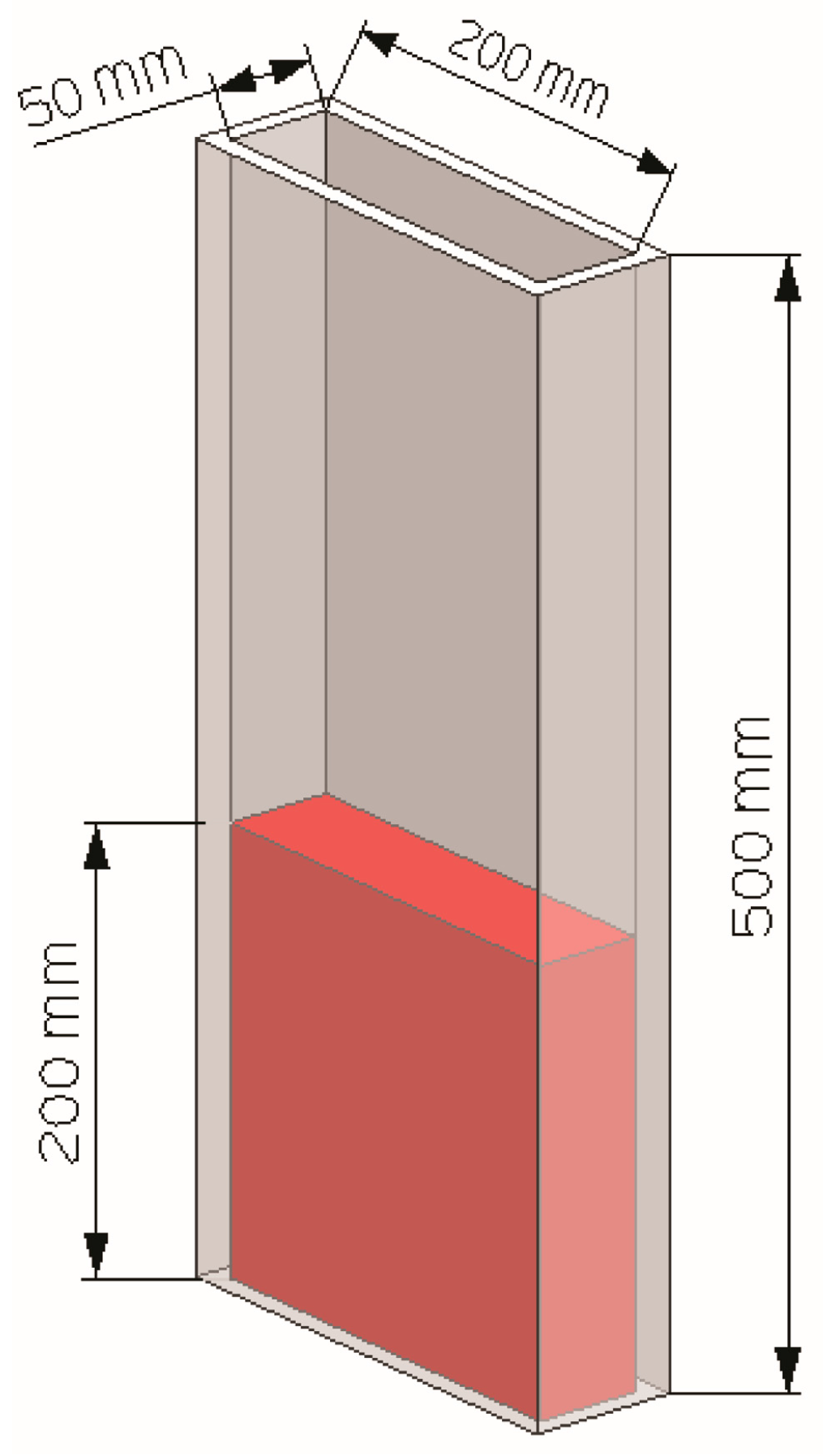
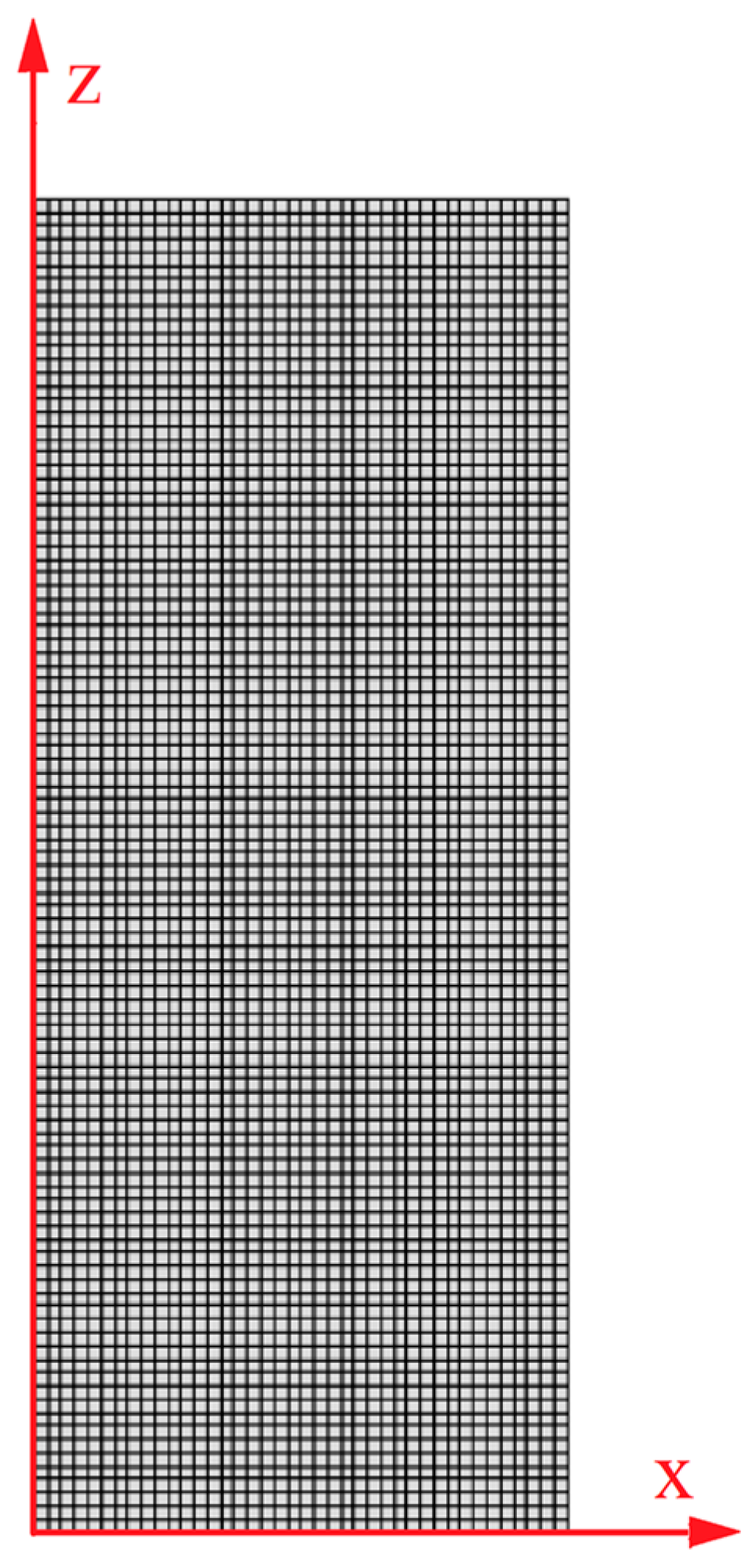
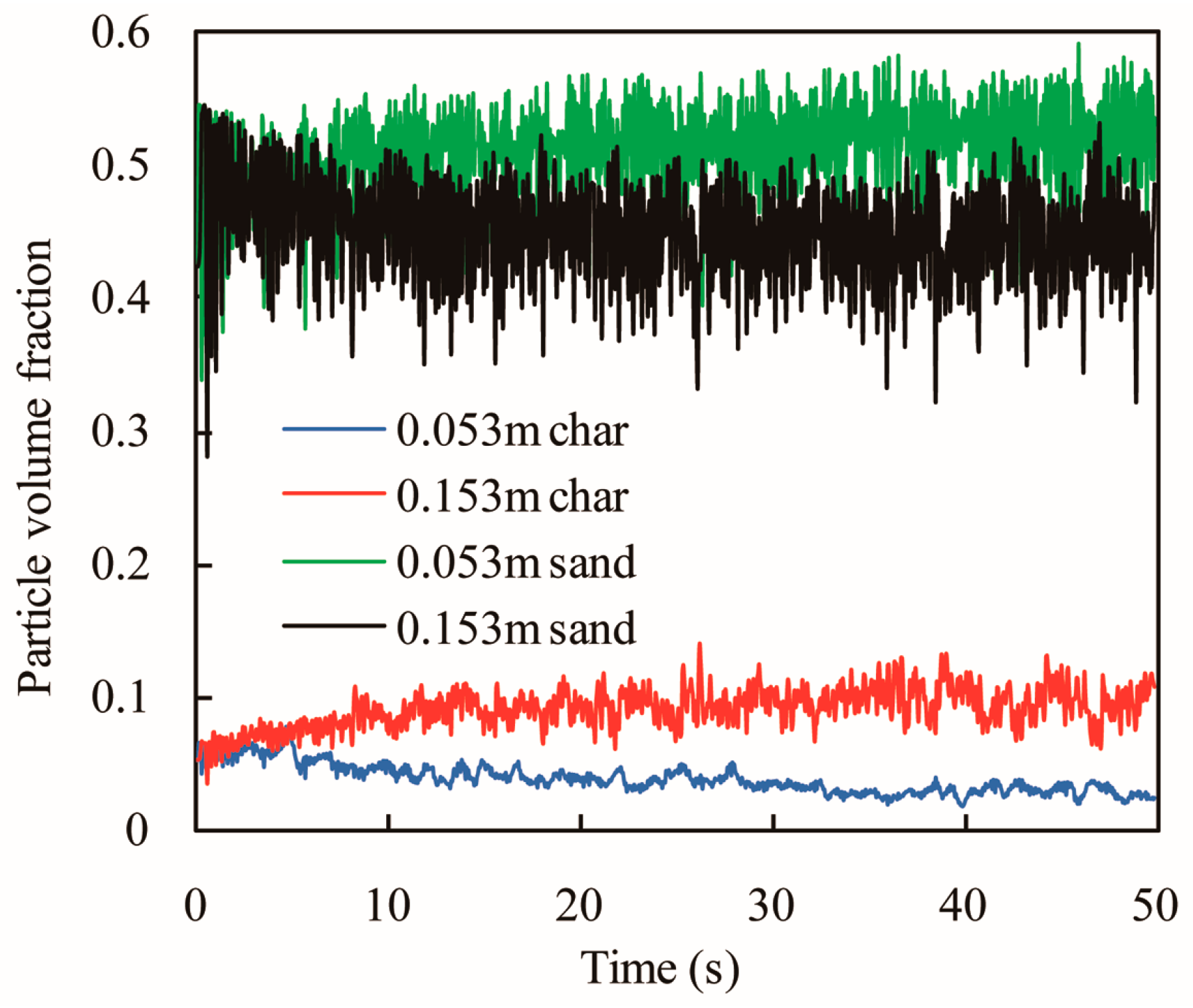
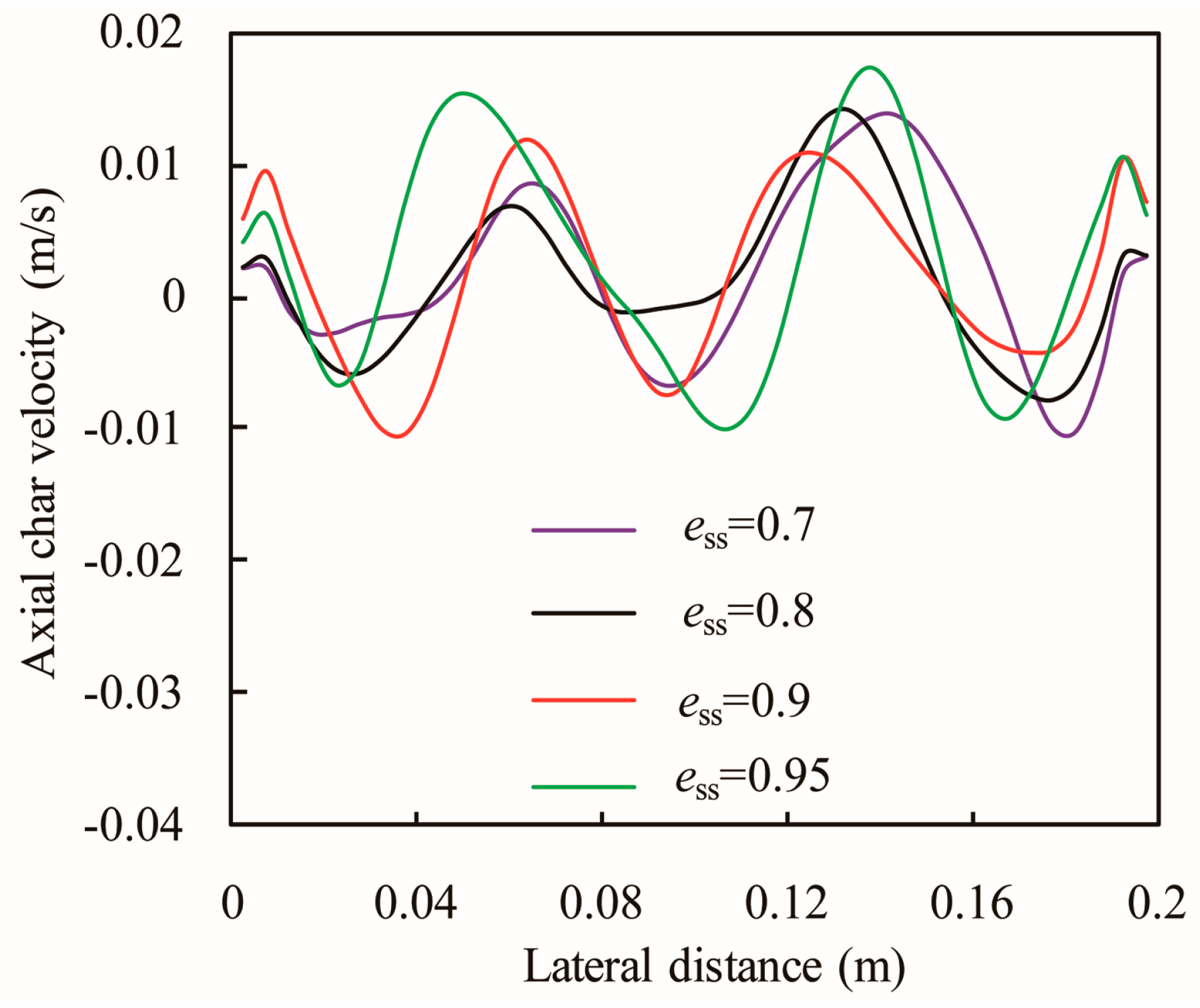

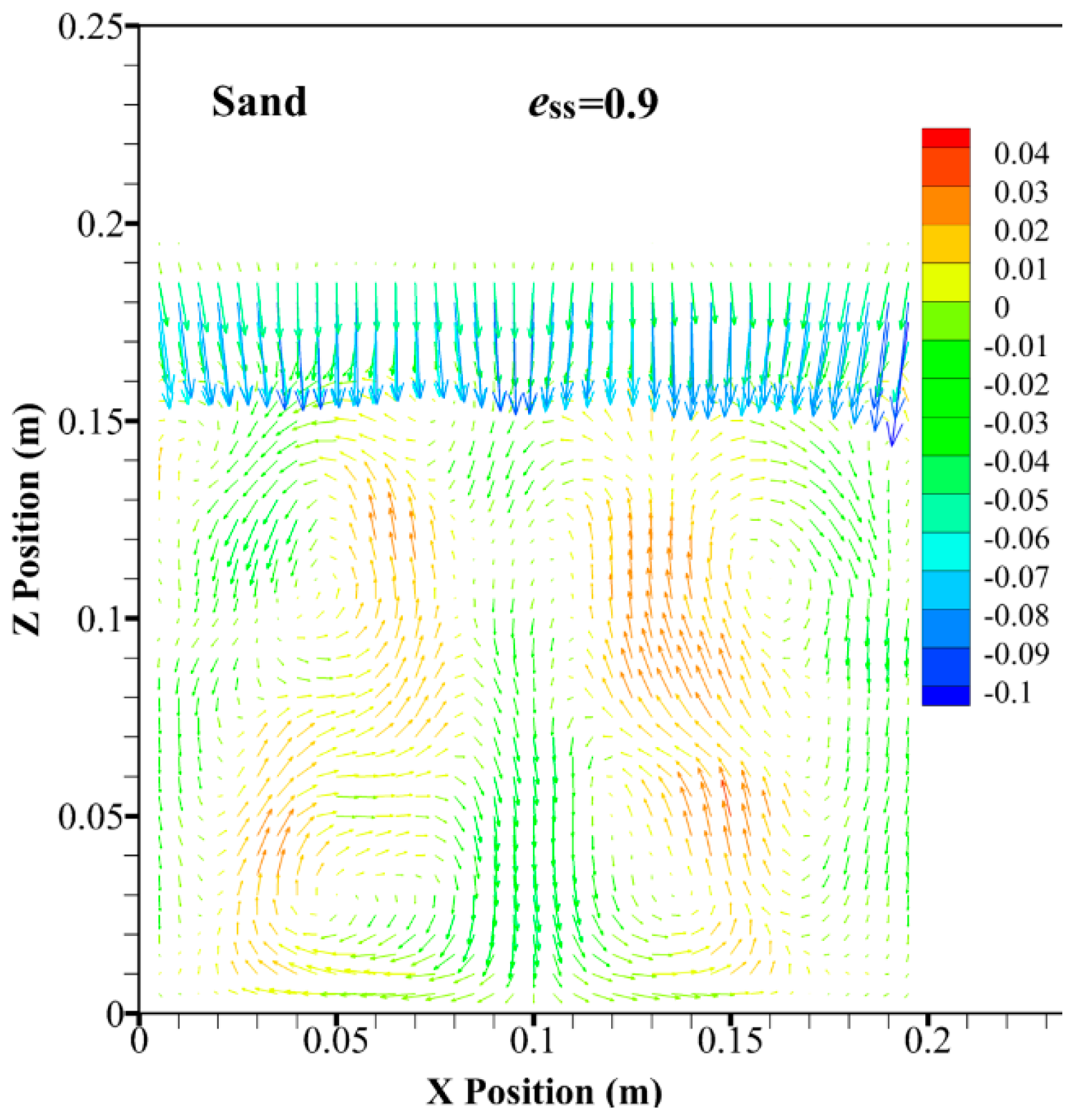
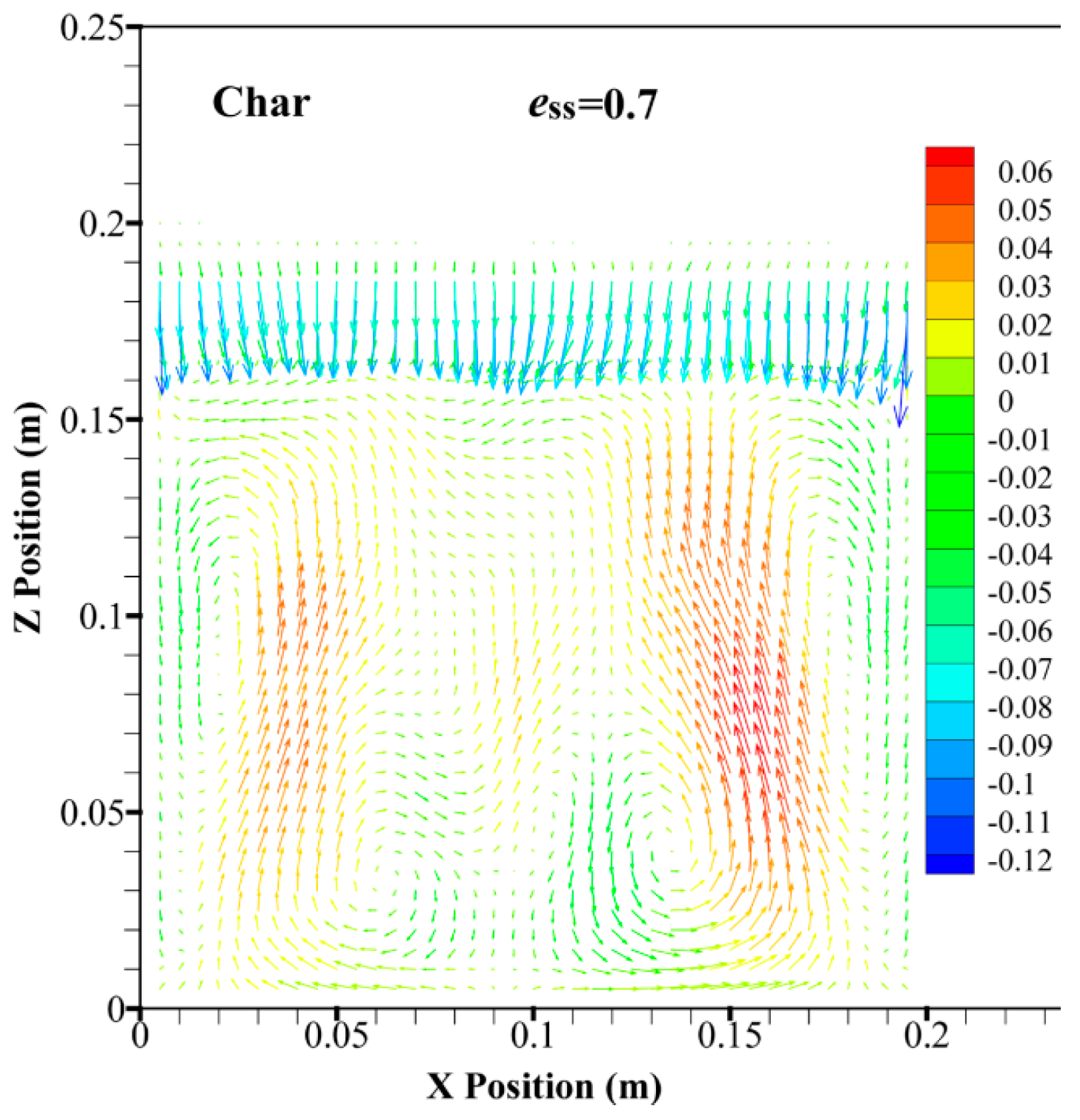

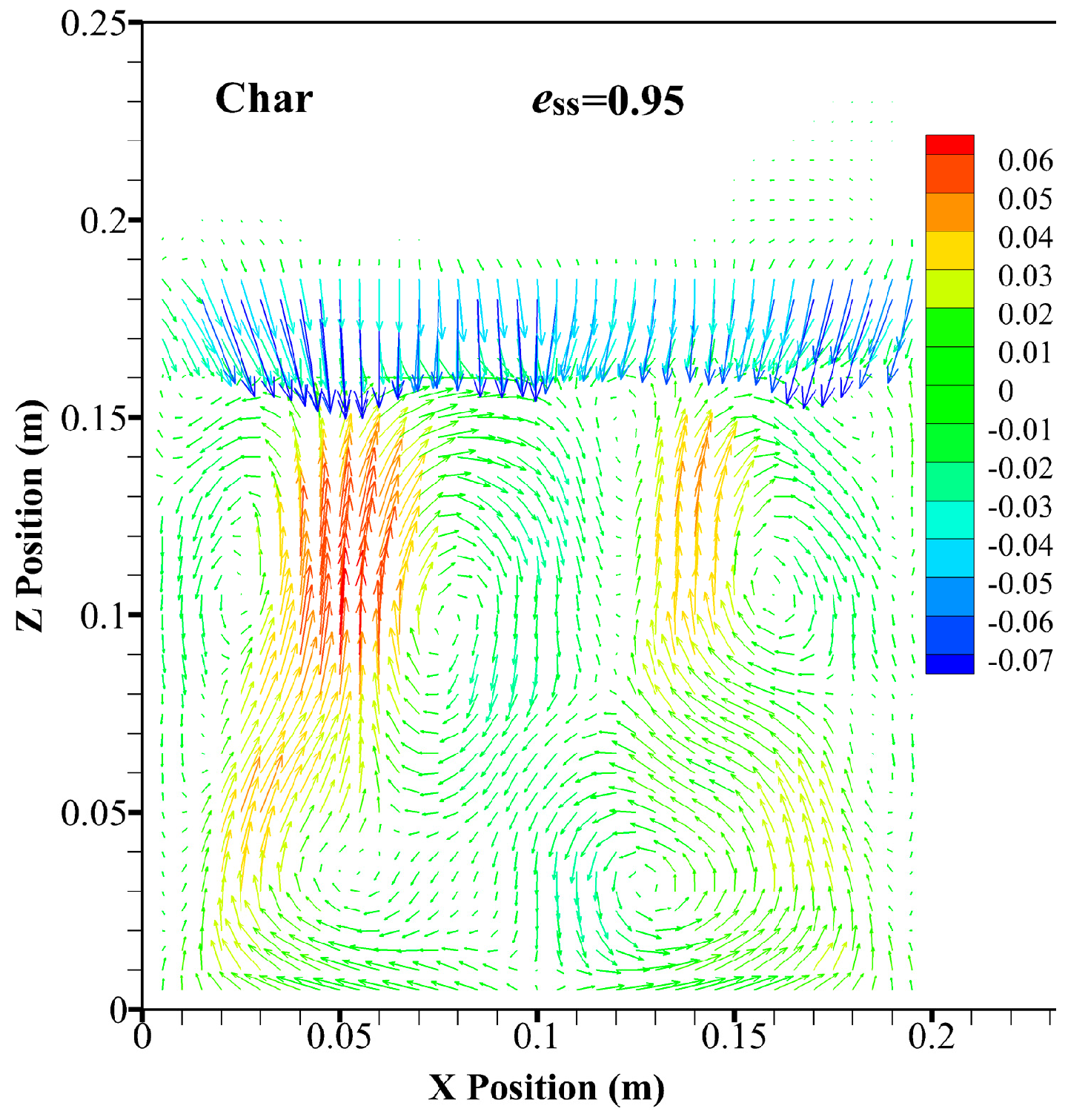


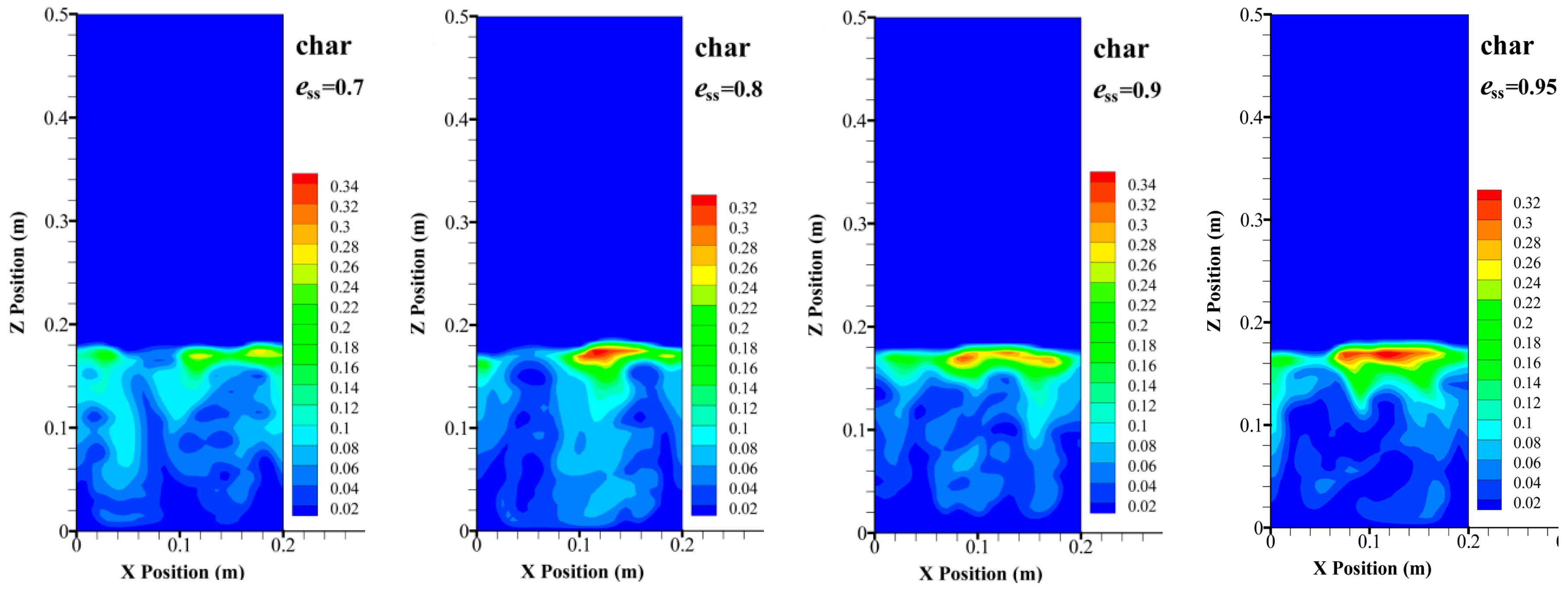

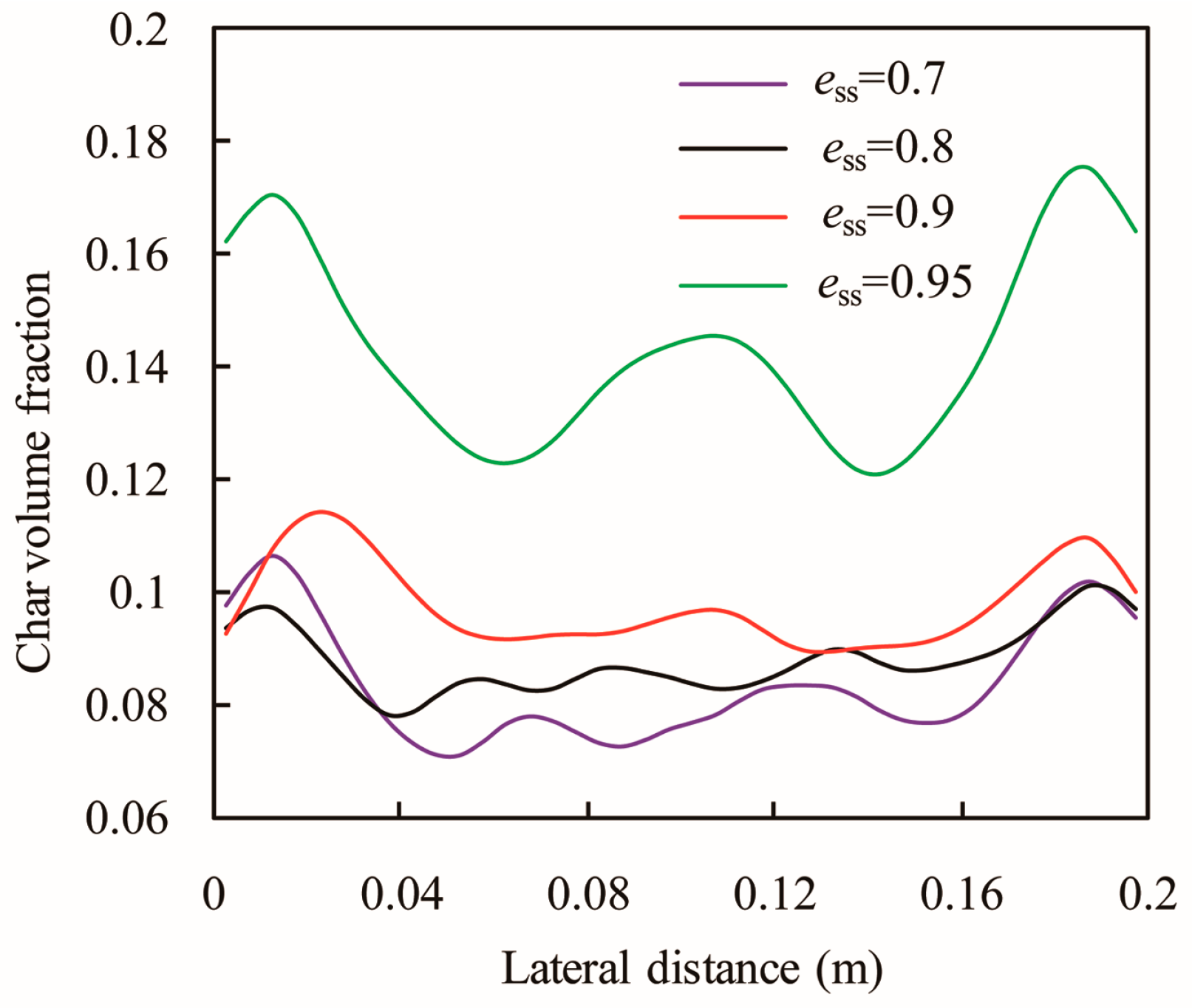
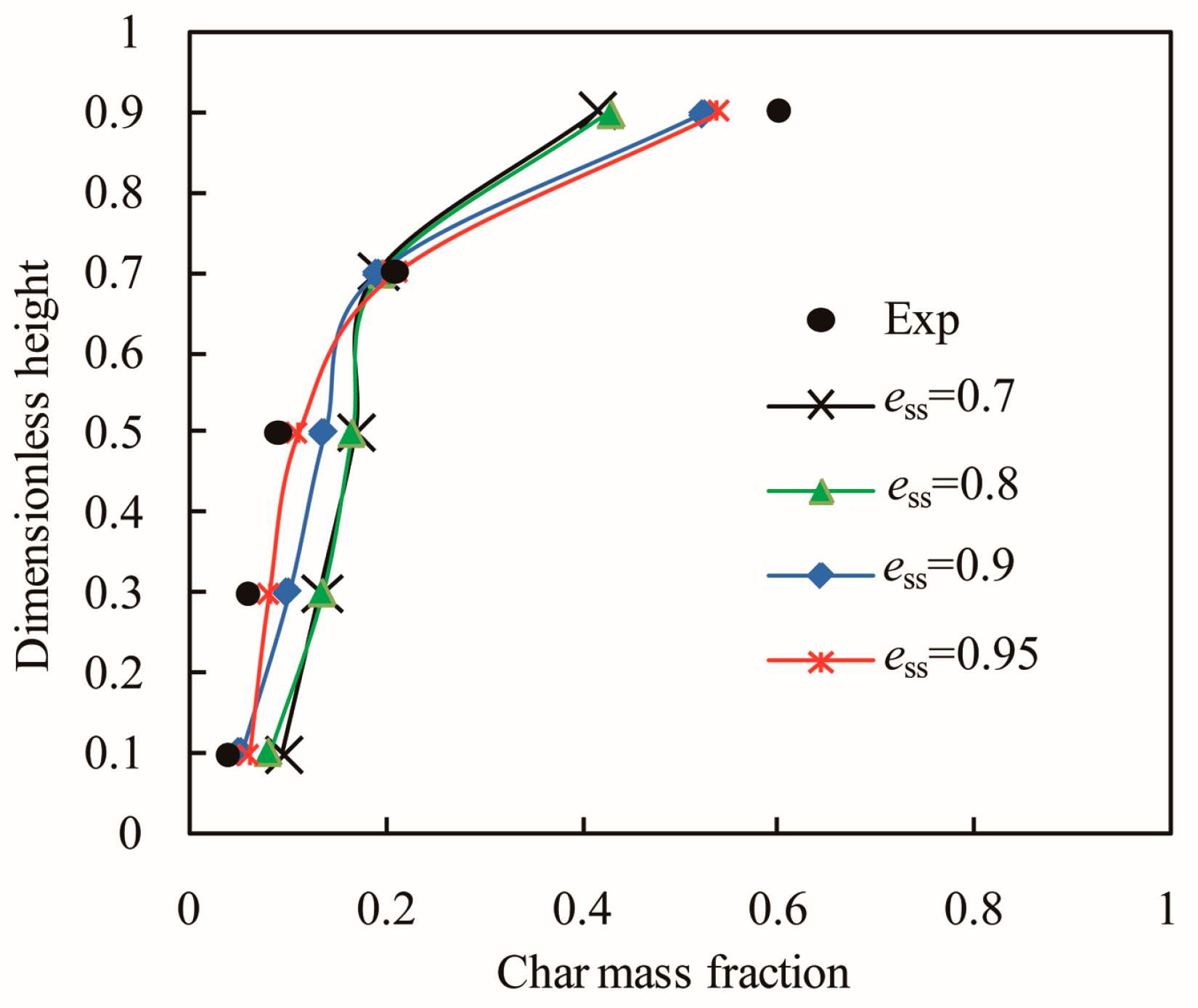
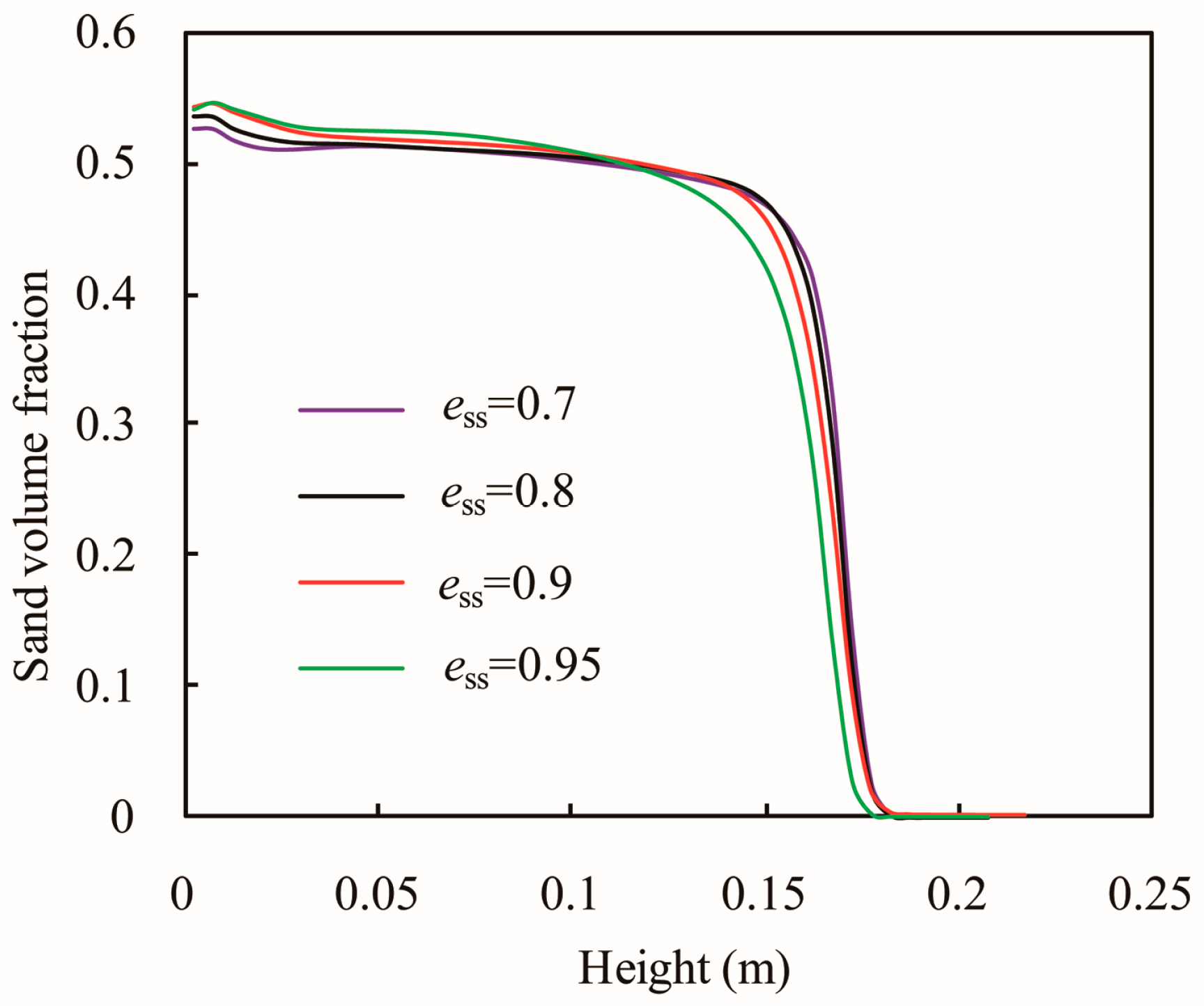
| Particles | Mean Diameter (μm) | Void Fraction | Bulk Density (kg/m3) |
|---|---|---|---|
| Sand | 387 | 0.333 | 1590 |
| Char | 957 | 0.693 | 120 |
| Parameter | Value or Model |
|---|---|
| Bed height (m) | 0.5 |
| Bed width (m) | 0.2 |
| Minimum fluidization velocity (m/s) | 0.14 |
| Superficial gas velocity (m/s) | 0.19 |
| Total particle weight (g) | Sand: 2000 Char: 40 |
| Particle volume fraction | Sand: 89% Char: 11% |
| Drag coefficient | Gidaspow |
| Granular viscosity | Syamlal-O’Brien |
| Granular bulk viscosity | Lun et al. |
| Restitution coefficient | ess = 0.7, 0.8, 0.9, 0.95 |
| Wall boundary condition | No-slip |
© 2017 by the authors. Licensee MDPI, Basel, Switzerland. This article is an open access article distributed under the terms and conditions of the Creative Commons Attribution (CC BY) license (http://creativecommons.org/licenses/by/4.0/).
Share and Cite
Zhao, X.; Eri, Q.; Wang, Q. An Investigation of the Restitution Coefficient Impact on Simulating Sand-Char Mixing in a Bubbling Fluidized Bed. Energies 2017, 10, 617. https://doi.org/10.3390/en10050617
Zhao X, Eri Q, Wang Q. An Investigation of the Restitution Coefficient Impact on Simulating Sand-Char Mixing in a Bubbling Fluidized Bed. Energies. 2017; 10(5):617. https://doi.org/10.3390/en10050617
Chicago/Turabian StyleZhao, Xinjun, Qitai Eri, and Qiang Wang. 2017. "An Investigation of the Restitution Coefficient Impact on Simulating Sand-Char Mixing in a Bubbling Fluidized Bed" Energies 10, no. 5: 617. https://doi.org/10.3390/en10050617






